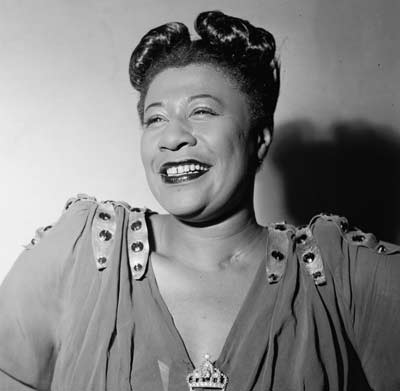 Ella Fitzgerald, New York, N.Y., ca. Nov. 1946 Ella Fitzgerald, New York, N.Y., ca. Nov. 1946
The History Of Vocal Jazz
The beginning
Instrumental Jazz music has always had a place in the hearts of Americans throughout the 20th century; people certainly embraced the musicians at the time. However, when the inovative singers started to improvise vocally, scat singing was born. Virtuoso jazz singers like Don Redman, Cliff Edwards, Red Nichols, Louis Armstrong and Duke Ellington came on the scene with strong skills in the art of scatting: that is vocal Jazz improvisation, expressively articulated but with the pizzazz to swing to the rhythms effectively.
Jazz music bore another gift on the American public to spread to the world during the 1940's when singers came together to form groups. The acapella sound of harmonizing jazz voices - like in a church choir - can be ethereal and divine
In fact, due to the success of such groups as the Mills Brothers, Boswell Sisters, Andrews sisters, and Modernaires during the 1930's 1940's made fans of vocal Jazz music seek more. As a result, record stores stocked up on vocal Jazz music, and it became the tremendous success that made quartets like Manhattan Transfer household names today.
Two of the very best known Jazz Singers are Billie Holiday and Ella Fitzgerald, the 'First Lady of Song'. Their jazz styles were fused to some extent with popular music of the time gave them mass appeal, and their music has continually been available.
America has the largest selection of vocal Jazz music even though there are vocal Jazz ensembles all over the world. These new vocal Jazz groups do not all sing a capella - ie, without music, the 'barber shop' style. Vocal Jazz groups commonly use a Jazz band to accompany them as they perform. Jazz music may not be as strict as classical music, but it is in a class all it's own. It takes great skill to sing Vocal Jazz as it does with Classical, and many other styles of music. Perhaps not everyone can be a good jazz soloist, but there are still plenty of opportunites to sing with a vocal jazz ensemble. Each singer must match in volume, resonance, and key in order to be a worthy member in the vocal Jazz ensemble. Every singer must be able to sing their parts, and be heard as well as blended into the group. There are times when different people in the vocal Jazz group will be asked to scat to the music, and take the challenges that some complex Jazz music holds with great skill.
All the beauty of the great vocal Jazz recordings of the past did not keep the style up there in terms of popularity. In the 60's the appeal of Jazz music was slipping - in part due to the increased complexity (some might say inaccessibility) of the music, but also due to the growing interest in Rock music. By the late 1970s the public showed little interest in a style that was considered pass笼/p>
But Jazz never lost its core following despite the ever-changing interests of the public, and Jazz singers have come and gone, with varying degrees of sucess. Fortunately, those who loved, and dedicated themselves to the music caused people to take notice from the latter part of the 80's to the millennium where Jazz singers came prepared to recreate Jazz again.

|